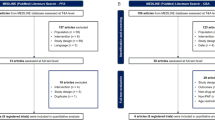Abstract
Introduction
Pulmonary vein isolation (PVI) is widely practiced for treating atrial fibrillation. Transseptal access is necessary with one or even more transseptal sheaths to perform PVI.
Methods
In this prospective study, 31 patients were examined with transesophageal echocardiography before, immediately after and in a 3-, 6- and 12-month follow-up period for evaluation of iatrogenic atrial septal defect (iASD). All patients underwent PVI with double transseptal puncture.
Results
An iASD was detected in 27/31 patients (87%) with a maximum diameter of 1.0 mm. After 3 months, the iASDs were completely closed in 26/27 (96.3%) patients. In 1/27 (3.7%) patients, there was an iASD detectable even after 12 months. Clinically no patient suffered from cerebral or cardiac embolism in the follow-up period.
Conclusions
We were only able to find small iASDs with left to right shunting after PVI but none with right to left shunting. iASDs following PVI show a high spontaneous closure rate already at 3 months of follow-up and are not associated with an increased rate of paradoxical embolism.


Similar content being viewed by others
References
Lin, W. S., Tai, C. T., Hsieh, M. H., et al. (2003). Catheter ablation of paroxysmal atrial fibrillation initiated by non-pulmonary vein ectopy. Circulation, 107, 3176–3183.
Pappone, C., Augello, G., Sala, S., et al. (2006). A randomized trial of circumferential pulmonary vein ablation versus antiarrhythmic drug therapy in paroxysmal atrial fibrillation: The APAF (Ablation for Paroxysmal Atrial Fibrillation) Study. Journal of the American College of Cardiology, 48, 2340–2347.
Haïssaguerre, M., Hocini, M., Sanders, P., et al. (2005). Catheter ablation of long-lasting persistent atrial fibrillation: Clinical outcome and mechanisms of subsequent arrhythmias. Journal of Cardiovascular Electrophysiology, 16, 1138–1147.
Oral, H., Pappone, C., Chugh, A., et al. (2006). Circumferential pulmonary-vein ablation for chronic atrial fibrillation. New England Journal of Medicine, 354, 934–941.
Fuster, V., Ryden, L. E., Cannom, D. S., et al. (2006). American College of Cardiology/American Heart Association Task Force on Practice Guidelines; European Society of Cardiology Committee for Practice Guidelines; European Heart Rhythm Association; Heart Rhythm Society. ACC/AHA/ESC 2006 guidelines for the management of patients with atrial fibrillation: A report of the American College of Cardiology/American Heart Association Task Force on Practice Guidelines and the European Society of Cardiology Committee for Practice Guidelines (Writing Committee to Revise the 2001 Guidelines for the Management of Patients With Atrial Fibrillation): Developed in collaboration with the European Heart Rhythm Association and the Heart Rhythm Society. Circulation, 114, e257–e354.
O’Neill, M. D., Jaïs, P., Hocini, M., et al. (2007). Catheter Ablation for Atrial Fibrillation. Circulation, 116, 1515–1523.
Haissaguerre, M., Jais, P., Shah, D. C., et al. (2000). Electrophysiological end point for catheter ablation of atrial fibrillation initiated from multiplepulmonary venous foci. Circulation, 101, 1409–1417.
Cappato, R., Calkins, H., Chen, S. A., et al. (2005). Worldwide survey on the methods, efficacy, and safety of catheter ablation for human atrial fibrillation. Circulation, 111, 1100–1105.
Hammerstingl, C., Lickfett, L., Jeong, K. M., Troatz, C., Wedekind, J. A., Tiemann, K., et al. (2006). Persistence of iatrogenic atrial septal defect after pulmonary vein isolation—An underestimated risk? American Heart Journal, 152(2), 362.e1–362.e5.
Sakata, Y., & Feldman, T. (2005). Transcatheter creation of atrial septal perforation using a radiofrequency transseptal system: Novel approach as an alternative to transseptal needle puncture. Catheterization and Cardiovascular Interventions, 64, 327–332.
Justino, H., Benson, L. N., & Nykanen, D. G. (2001). Transcatheter creation of an atrial septal defect using radiofrequency perforation. Catheterization and Cardiovascular Interventions, 54, 83–87.
Krishnamoorthy, K. M., & Dash, P. K. (2001). Transseptal catheterization without needle puncture. Scandinavian Cardiovascular Journal, 35, 199–200.
De Ponti, R., Cappato, R., Curnis, A., et al. (2006). Trans-septal catheterization in the electrophysiology laboratory: Data from a multicenter survey spanning 12 years. Journal of the American College of Cardiology, 47, 1037–1042.
Obel, O., Mansour, M., Picard, M., Ruskin, J., & Keane, D. (2004). Persistence of septal defects after transeptal puncture for pulmonary vein isolation procedures. Pacing and Clinical Electrophysiology, 27, 1411–1414.
Homma, S., & Sacco, R. L. (2005). Patent foramen ovale and stroke. Circulation, 112, 1063–1072.
Lechat, P., Mas, J. L., Lascault, G., et al. (1988). Prevalence of patent foramen ovale in patients with stroke. New England Journal of Medicine, 318, 1148–1152.
Lickfett, L., Hackenbroch, M., Lewalter, T., et al. (2006). Cerebral diffusion-weighted magnetic resonance imaging: A tool to monitor the thrombogenicity of left atrial catheter ablation. Journal of Cardiovascular Electrophysiology, 17, 1–7.
Yoshida, K., Yoshikawa, J., Akasaka, T., et al. (1989). Assessment of left-to-right atrial shunting after percutaneous mitral valvuloplasty by transesophageal color Doppler flow-mapping. Circulation, 80, 1521–1526.
Gibo, H., Carver, C. C., Rhoton, A. L., Jr., Lenkey, C., & Mitchell, R. J. (1981). Microsurgical anatomy of the middle cerebral artery. Journal of Neurosurgery, 54, 151–169.
Azarbal, B., Tobis, J., Suh, W., Chan, V., Dao, C., & Gaster, R. (2005). Association of interatrial shunts and migraine headaches: Impact of transcatheter closure. Journal of the American College of Cardiology, 45(4), 489–492.
Author information
Authors and Affiliations
Corresponding author
Additional information
Poster presentation: ESC 2007, Vienna.
Oral communication: Venice arrhythmias 2007, Venice.
Rights and permissions
About this article
Cite this article
Rillig, A., Meyerfeldt, U., Birkemeyer, R. et al. Persistent iatrogenic atrial septal defect after pulmonary vein isolation. J Interv Card Electrophysiol 22, 177–181 (2008). https://doi.org/10.1007/s10840-008-9257-7
Received:
Accepted:
Published:
Issue Date:
DOI: https://doi.org/10.1007/s10840-008-9257-7




